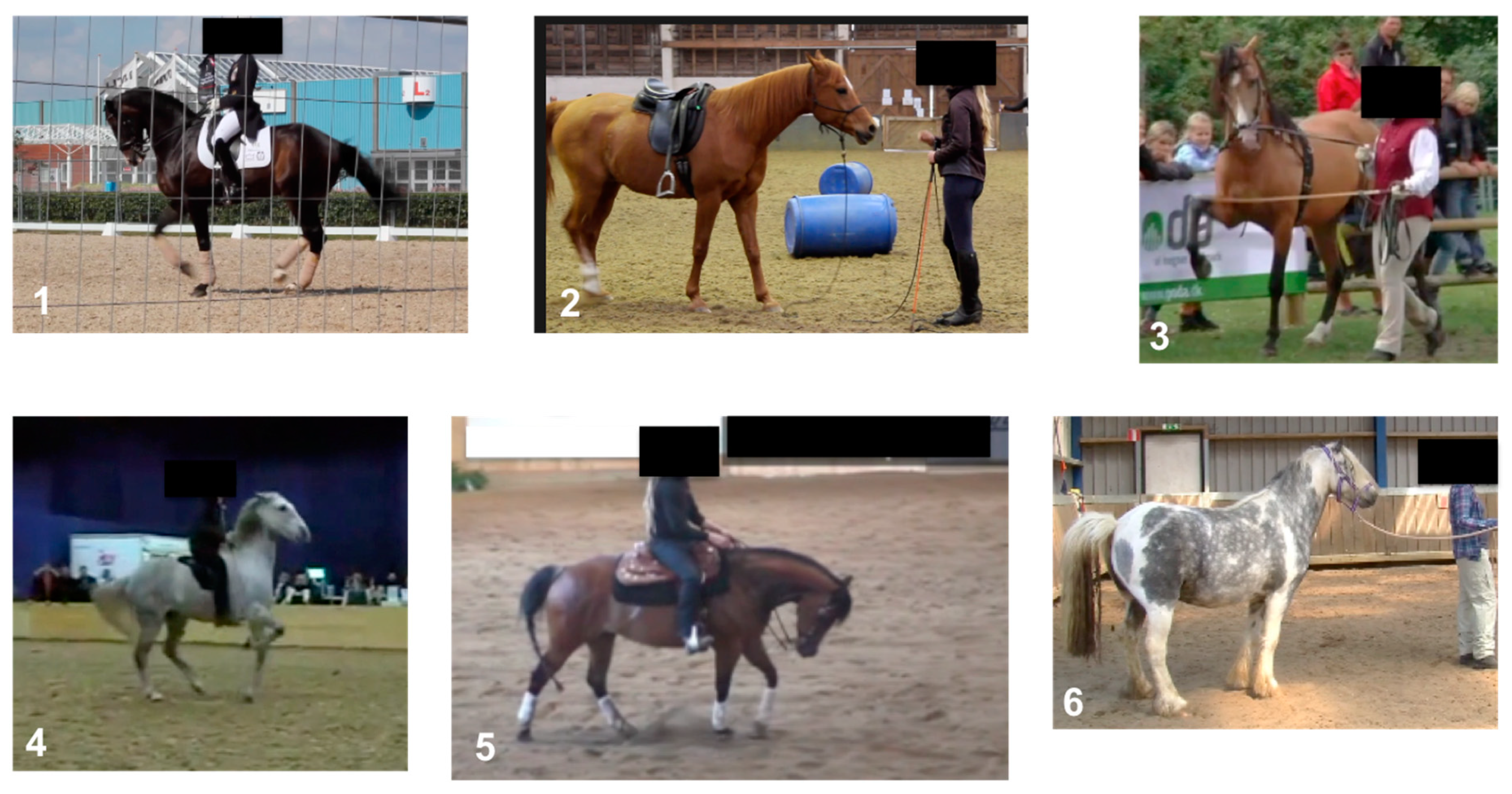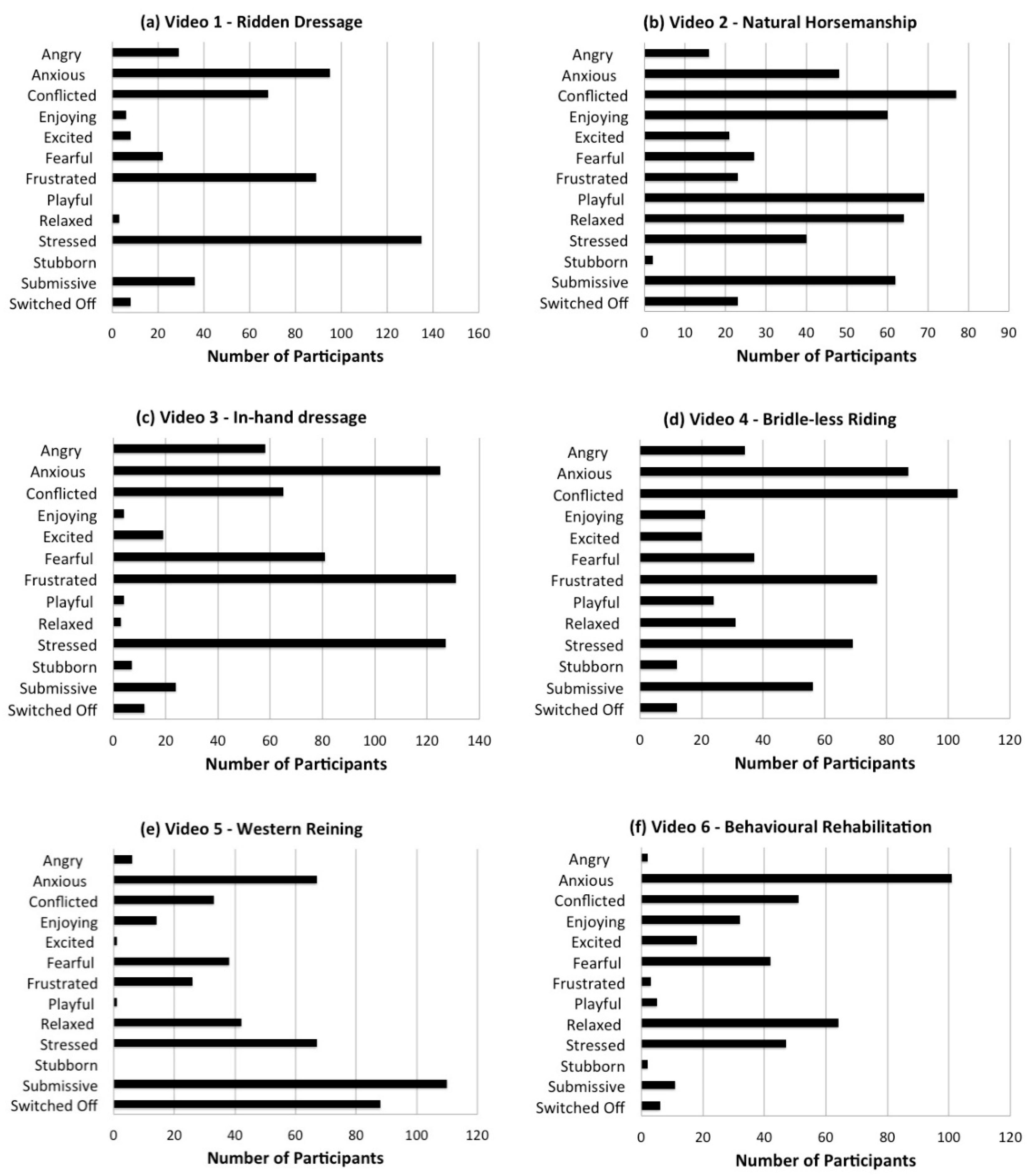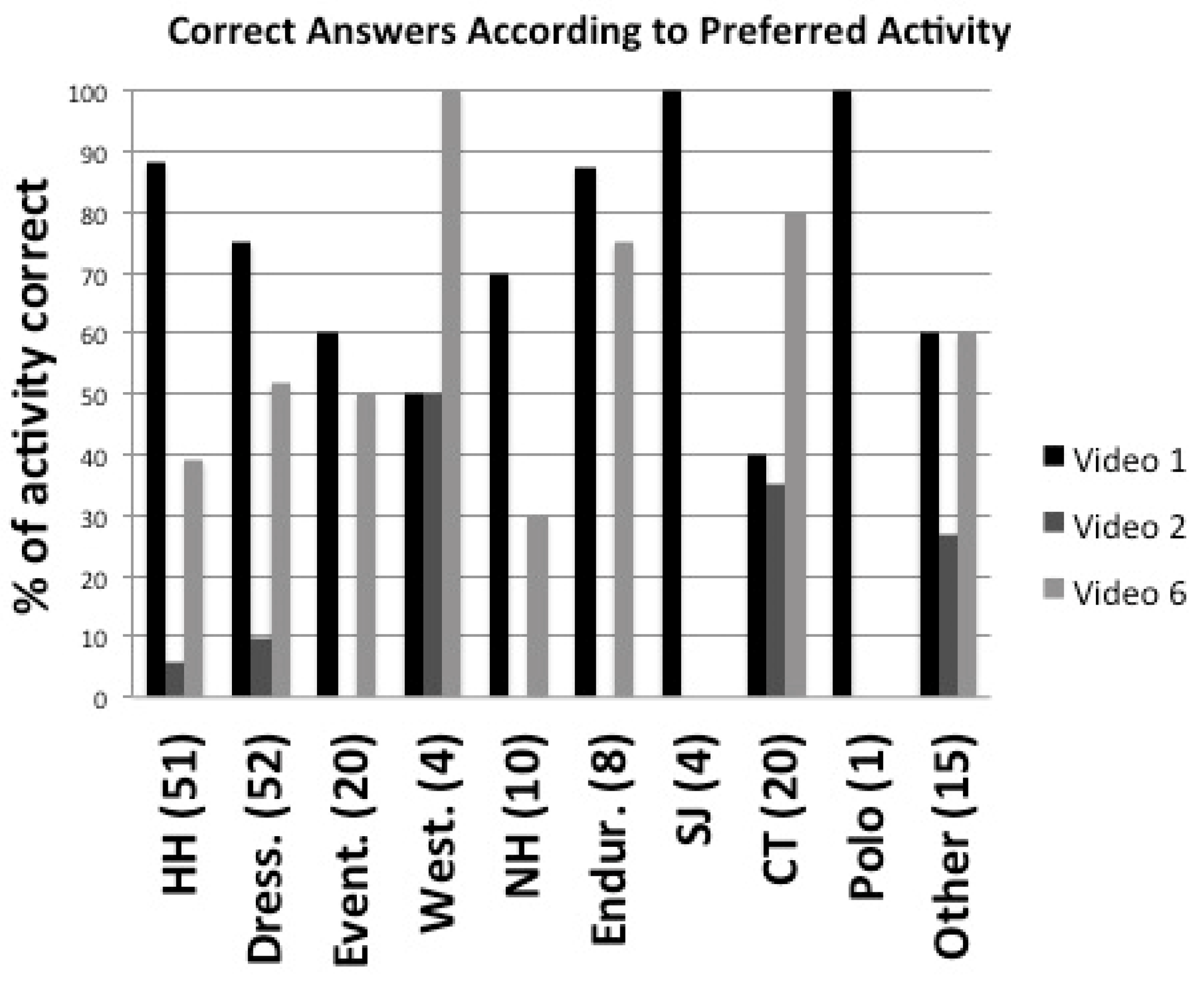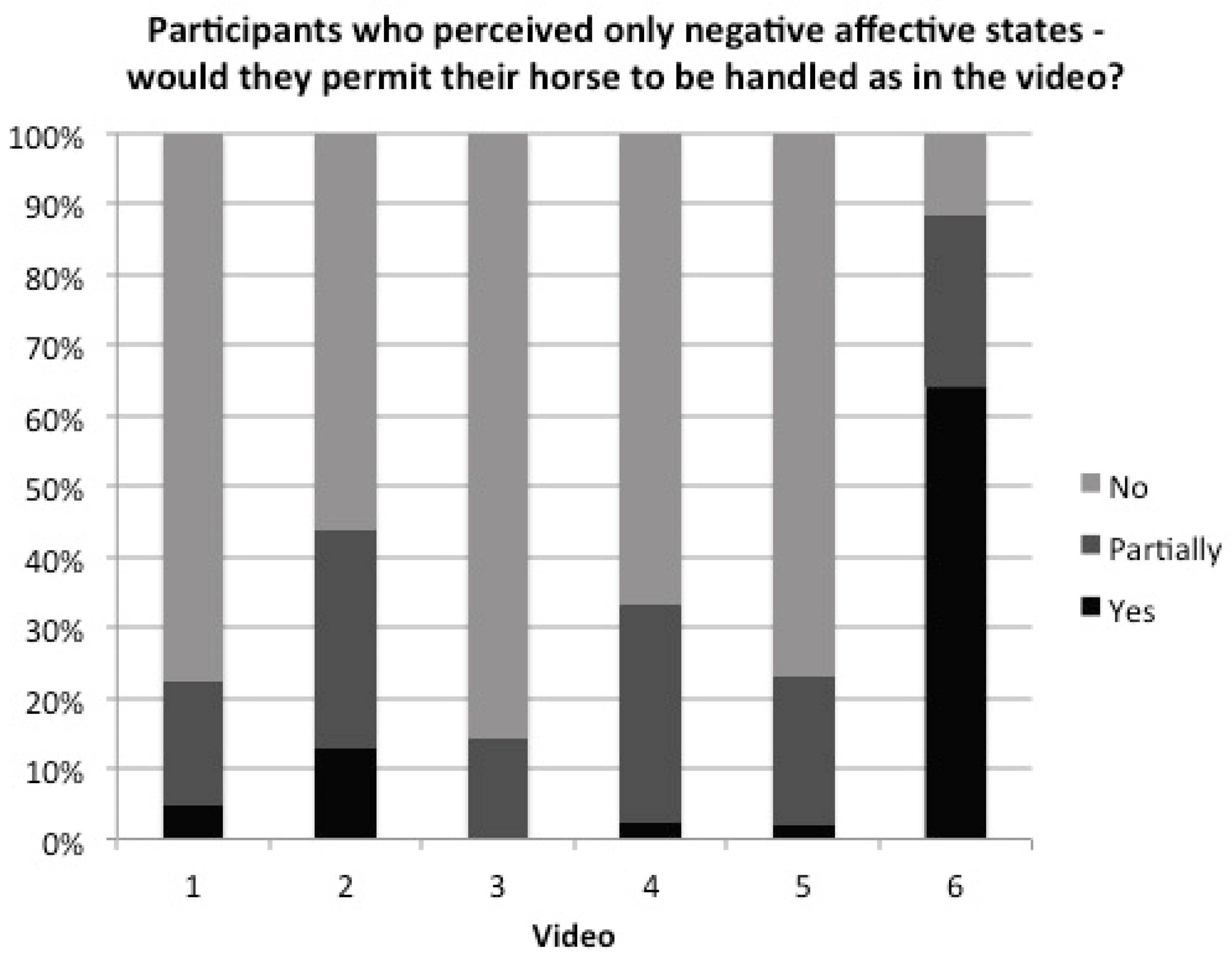Improving the Recognition of Equine Affective States
Simple Summary
Abstract
1. Introduction
2. Materials and Methods
2.1. Respondents
2.2. Materials
2.3. Procedure
3. Results
3.1. Expert Responses
3.2. Participant Responses
4. Discussion
4.1. Limitations
4.2. Suggestions for Future Study
Author Contributions
Funding
Acknowledgments
Conflicts of Interest
References
- Horseman, S.V.; Mullan, S.; Barr, A.; Knowles, T.G.; Buller, H.; Whay, H.R. Horses in Our Hands. Available online: http://www.worldhorsewelfare.org/survey-equine-welfare-england-and-wales (accessed on 22 August 2019).
- Equine Behaviour and Training Association. Available online: http://www.ebta.co.uk/lof.html (accessed on 23 August 2019).
- Shepherd, K. Behavioural medicine as an integral part of veterinary practice. In BSAVA Manual of Canine and Feline Behaviour, 2nd ed.; Horwitz, D., Mills, D., Eds.; BSAVA: Gloucester, UK, 2009; pp. 13–16. [Google Scholar] [CrossRef]
- Dalla Costa, E.; Minero, M.; Lebelt, D.; Stucke, D.; Canali, E.; Leach, M. Development of the Horse Grimace Scale (HGS) as a Pain Assessment Tool in Horses Undergoing Routine Castration. PLoS ONE 2014, 9, e92281. [Google Scholar] [CrossRef] [PubMed]
- Dyson, S.; Berger, J.; Ellis, A.D.; Mullard, J. Development of an ethogram for a pain scoring system in ridden horses and its application to determine the presence of musculoskeletal pain. J. Vet. Behav. 2018, 23, 47–57. [Google Scholar] [CrossRef]
- Gleerup, K.B.; Forkman, B.; Lindegaard, C.; Anderson, P.H. An Equine Pain Face. Vet. Anaethesia Analg. 2015, 42, 103–114. [Google Scholar] [CrossRef] [PubMed]
- McGreevy, P. Ch. 6: Communication. In Equine Behavior: A Guide for Veterinarians and Equine Scientists; Saunders: London, UK, 2004. [Google Scholar]
- König v Borstel, U.; Visser, E.K.; Hall, C. Indicators of Stress in Equitation. Appl. Anim. Behav. Sci. 2017, 190, 43–56. [Google Scholar] [CrossRef]
- Young, T.; Creighton, E.; Smith, T.; Hosie, C. A novel scale of behavioural indicators of stress for use with domestic horses. Appl. Anim. Behav. Sci. 2012, 140, 33–43. [Google Scholar] [CrossRef]
- Hintze, S.; Smith, S.; Patt, A.; Bachmann, I.; Würbel, H. Are Eyes a Mirror of the Soul? What Eye Wrinkles Reveal about a Horse’s Emotional State. PLoS ONE 2016, 11, e0164017. [Google Scholar] [CrossRef] [PubMed]
- Merkies, K.; Ready, C.; Farkas, L.; Hodder, A. Eye Blink Rates and Eyelid Twitches as a Non-Invasive Measure of Stress in the Domestic Horse. Animals 2019, 9, 562. [Google Scholar] [CrossRef] [PubMed]
- Hall, C.; Heskie, C. The role of the ethogram in equitation science. Appl. Anim. Behav. Sci. 2017, 190, 102–110. [Google Scholar] [CrossRef]
- Hockenhull, J.; Creighton, E. The strengths of statistical techniques in identifying patterns underlying apparently random behavioral problems in horses. J. Vet. Behav. 2012, 7, 305–310. [Google Scholar] [CrossRef]
- Squibb, K.; Grin, K.; Favier, R.; Ijichi, C. Poker Face: Discrepancies in behaviour and affective states in horses during stressful handling procedures. Appl. Anim. Behav. Sci. 2018, 202, 34–38. [Google Scholar] [CrossRef]
- Budzynska, M. Stress reactivity and coping in horse adaptation to environment. J. Equine Vet. Sci. 2014, 34, 935–941. [Google Scholar] [CrossRef]
- Hall, C.; Goodwin, D.; Heleski, C.; Randle, H.; Waran, N. Is There Evidence of Learned Helplessness in Horses? J. Appl. Anim. Welf. Sci. 2008, 11, 249–266. [Google Scholar] [CrossRef] [PubMed]
- Furieux, C.; Jego, P.; Henry, S.; Lansade, L.; Hausberger, M. Towards an Ethological Animal Model of Depression? A Study on Horses. PLoS ONE 2012, 7, e39280. [Google Scholar] [CrossRef] [PubMed]
- Furieux, C.; Beaulieu, C.; Argaud, S.; Rochais, C.; Quinton, M.; Henry, S.; Hausberger, M.; Mason, G. Investigating anhedonia in a non-conventional species: Do some riding horses Equus caballus display symptoms of depression? Appl. Anim. Behav. Sci. 2015, 162, 26–36. [Google Scholar] [CrossRef]
- Starling, M.; McClean, A.; McGReevy, P. The Contribution of Equitation Science to Minimising Horse-Related Risks to Humans. Animals 2016, 6, 15. [Google Scholar] [CrossRef] [PubMed]
- Rogers, S. Horses—Happy, Brave Athletes or Stressed and Lonely; Vet Times: Peterborough, UK, 2014; Available online: https://www.vettimes.co.uk/app/uploads/wp-post-to-pdf-enhanced-cache/1/horses-happy-brave-athletes-or-stressed-and-lonely.pdf (accessed on 29 August 2019).
- Henshall, C.; McGreevy, P.D. The role of ethology in round pen horse training. Appl. Anim. Behav. Sci. 2014, 155, 1–11. [Google Scholar] [CrossRef]
- Hall, C.; Randle, H.; Pearson, G.; Preshaw, L.; Waran, N. Assessing equine emotional state. Appl. Anim. Behav. Sci. 2018, 205, 183–193. [Google Scholar] [CrossRef]
- Hockenhull, J.; Creighton, E. Management practices associated with owner-reported stable-related and handling behaviour problems in UK leisure horses. Appl. Anim. Behav. Sci. 2014, 155, 49–55. [Google Scholar] [CrossRef]
- Mills, D.S. Personality and individual differences in the horse, their significance, use and measurement. Equine Vet. J. Suppl. 1998, 27, 10–13. [Google Scholar] [CrossRef] [PubMed]
- Waran, N.; Randle, H. What we can measure, we can manage: The importance of using robust welfare indicators in Equitation Science. Appl. Anim. Behav. Sci. 2017, 190, 74–81. [Google Scholar] [CrossRef]
- Fédération Equestre Internationale. FEI Rules for Dressage Events, 23rd ed.; Fédération Equestre Internationale: Lausanne, Switzerland, 2009. [Google Scholar]





| Video | Expert Response |
|---|---|
| Video 1 | Conflicted (4) Frustrated (4) Stressed (6) Anxious (3) Fearful (2) Submissive (1) Switched-off (1) Angry (0) Enjoying (0) Excited (0) Playful (0) Relaxed (0) Stubborn (0) |
| Video 2 | Stressed (4) Anxious (3) Conflicted (3) Fearful (2) Frustrated (3) Submissive (1) Switched-off (3) Angry (0) Enjoying (0) Excited (0) Playful (0) Relaxed (0) Stubborn (0) |
| Video 3 | Conflicted (4) Fearful (4) Frustrated (4) Stressed (6) Angry (1) Anxious (3) Submissive (1) Enjoying (0) Excited (0) Playful (0) Relaxed (0) Stubborn (0) Switched-off (0) |
| Video 4 | Fearful (5) Stressed (6) Submissive (4) Anxious (3) Conflicted (3) Frustrated (2) Switched-off (2) Angry (0) Enjoying (0) Excited (0) Playful (0) Relaxed (0) Stubborn (0) |
| Video 5 | Fearful (4) Stressed (5) Submissive (4) Switched-off (5) Anxious (3) Conflicted (3) Frustrated (2) Angry (0) Enjoying (0) Excited (0) Playful (0) Relaxed (0) Stubborn (0) |
| Video 6 | Anxious (4) Conflicted (6) Fearful (3) Frustrated (1) Relaxed (1) Stressed (3) Angry (0) Enjoying (0) Excited (0) Playful (0) Stubborn (0) Submissive (0) Switched-off (0) |
| Predictor Variable | Sig. (P) | Odds Ratio (exp (B)) | 95% Conf. Int. |
|---|---|---|---|
| Ref. (Video 6: behavioural rehab.) | - | 1 | - |
| Video 1 (ridden dressage) | <0.01 | 3.23 | 2.05–5.10 |
| Video 2 (natural horsemanship) | <0.01 | 0.12 | 0.07–0.21 |
| Video 3 (in-hand dressage) | <0.01 | 3.25 | 2.06–5.11 |
| Video 4 (bridle-less riding) | <0.01 | 0.46 | 0.30–0.71 |
| Video 5 (Western reining) | <0.010 | 2.41 | 1.56–3.73 |
| Ref. (Experienced) | - | 1 | - |
| Past Experience | <0.01 | 0.18 | 0.09–0.35 |
| Not an Owner | 0.02 | 0.37 | 0.16–0.86 |
| Ref. (Polo) | - | 1 | - |
| Clicker Training | 0.05 | 9.77 | 0.97–98.15 |
© 2019 by the authors. Licensee MDPI, Basel, Switzerland. This article is an open access article distributed under the terms and conditions of the Creative Commons Attribution (CC BY) license (http://creativecommons.org/licenses/by/4.0/).
Share and Cite
Bell, C.; Rogers, S.; Taylor, J.; Busby, D. Improving the Recognition of Equine Affective States. Animals 2019, 9, 1124. https://doi.org/10.3390/ani9121124
Bell C, Rogers S, Taylor J, Busby D. Improving the Recognition of Equine Affective States. Animals. 2019; 9(12):1124. https://doi.org/10.3390/ani9121124
Chicago/Turabian StyleBell, Catherine, Suzanne Rogers, Julie Taylor, and Debbie Busby. 2019. "Improving the Recognition of Equine Affective States" Animals 9, no. 12: 1124. https://doi.org/10.3390/ani9121124
APA StyleBell, C., Rogers, S., Taylor, J., & Busby, D. (2019). Improving the Recognition of Equine Affective States. Animals, 9(12), 1124. https://doi.org/10.3390/ani9121124




